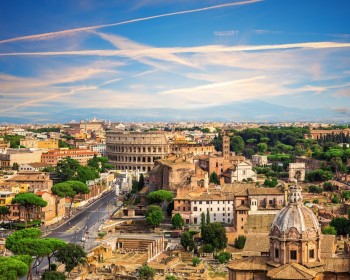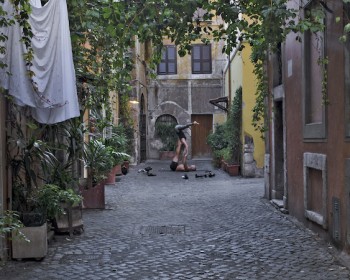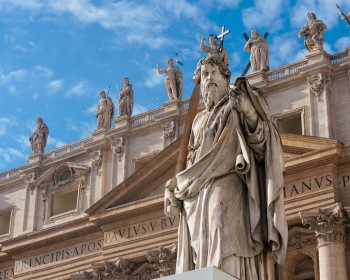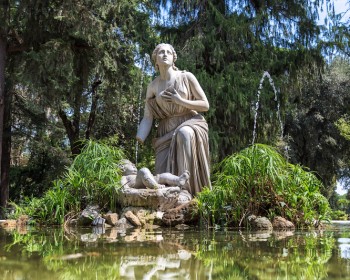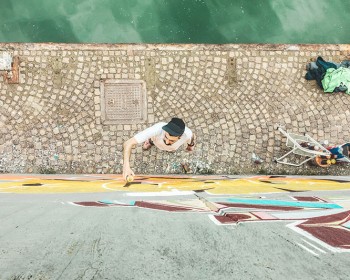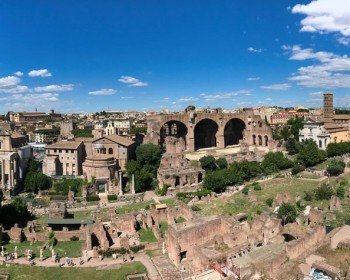Did you know that Piazza Navona and the Pantheon are separated by a tiny rione? It is Sant’Eustachio! Characterized by a Renaissance style, it includes both religious and residential buildings.
Due to its long and very narrow shape, Sant’Eustachio’s boundaries run very close to many of Rome’s historical sites, though among the major highlights none is included in its territory.
History
In ancient times Sant’Eustachio was the central part of Campus Martius – today a separate rione – where a lot of important and official buildings stood – but none of them stands still! –. During the Middle Ages the area was rebuilt, with a high density of small private houses and inhabited by the low and middle social classes.
At the end of the 19th century, Sant’Eustachio went through many destructions and changes, for example it was built Corso del Rinascimento to sign the west boundary of the area.
Its coat of arms represents the head of a stag with a cross between its antlers – the symbol of Saint Eustace –. The figure is golden on a red background.
Discover our ➡️ Best of the Vatican Private Guided Tour
What to see
Below a list of some highlights not so famous, but totally worth visiting.
- Basilica di Sant’Eustachio
The very core of the district is the charming square named after the saint: Saint Eustace’s church, a Roman Catholic minor basilica. Enduring since the 8th century – possibly even earlier! – it is recorded as an ancient center for helping the poor and the sick. During the Middle Ages the church was restored and the bell tower was built. The peculiarity of Sant’Eustachio’s façade is the presence of a stag’s head bearing the cross, placed exactly at the top of its tympanum. According to the tradition the basilica was built exactly on the place where the Saint and his wife were killed. Don’t forget to visit the interior to admire its Baroque style!
- Chiesa di Sant’Ivo alla Sapienza
Built between 1642 and 1660 by the architect Francesco Borromini, it is a masterpiece of Roman Baroque architecture. The church is located at the rear of a courtyard and nowadays it is used by the State Archives of Rome. The name derives from “Yves”, the patron of the jurists, and “La Sapienza”, the University of Rome whose chapel was located right there in the 14th century. Its façade is concave, as it was part of the courtyard’s wall. But the most amazing thing is the spiral-shaped cupola, surmounted by a ring of flames, a cage and a globe bearing a cross, which as a whole represent a crown. Don’t miss a visit!
- Basilica di Sant’Agostino
It is one of the first Roman churches built during the Renaissance, whose façade was built using travertine taken from the Colosseum. Sant’Agostino is house to a very renowned work of art: the Madonna di Loreto, an important early Baroque painting by Caravaggio, hosted in the Cavalletti Chapel. The church also contains a fresco by Raphael and next to it there is the Biblioteca Angelica, a library founded in 1605.
Chiesa di San Luigi dei Francesi
Built thanks to Caterina de' Medici during the reigns of Luis XV and XVI (1518-1589), it is the National Church of France in Rome. The French character of the façade is evident in the statues recalling the national history, for example Charlemagne. Inside the church, the Contarelli Chapel contains a cycle of Caravaggio's paintings about the life of St. Matthews: the world-renowned canvases "St. Matthew and the Angel", "The Martyrdom" and "the Vocation". Don’t miss the chance to admire these works, they will take your breath away!
- Palazzo Madama
Built on top of the ruins of the ancient baths of Nero, Palazzo Madama was completed in 1505 for the Medici family. The current façade was built later, adding the ornate cornice and whimsical decorative urns on the roof, as well. After the extinction of the Medici family the palace was handed over to the Papal government. Just after the conquest of Rome by the new Kingdom of Italy, Palazzo Madama became the seat of the “Senato del Regno” – nowadays the Senate of the Italian Republic –.
How to get to Rione Sant'Eustachio
You can get to Sant’Eustachio by underground: take the A-line, the orange one, and get off at Barberini or Spagna stops. Then you have to walk just for almost 15 minutes. Otherwise double check on the ATAC website to calculate the best route for you. There are many buses stopping in Corso del Rinascimento: 81, 87, 492, 628, and many others.
Peculiarity
Nowadays the name Sant’Eustachio is equivalent to the best and famous coffee in Rome. Exactly in the Piazza there is “Sant’Eustachio il caffè” where thanks to a secret method – the inventors preserve it scrupulously! – it is possible to taste a delicious cup of Italian espresso. It will be a special experience!



